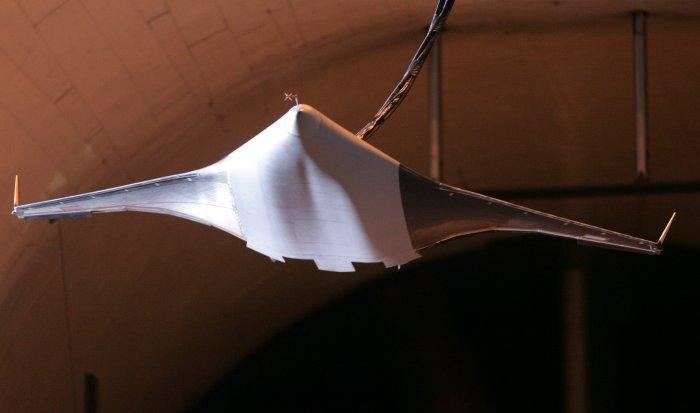 | ||
A Blended wing body (BWB or Hybrid Wing Body, HWB) is a fixed-wing aircraft having no clear dividing line between the wings and the main body of the craft. The form is composed of distinct wing and body structures, though the wings are smoothly blended into the body, unlike a flying wing which has no distinct fuselage. A BWB design may or may not be tailless.
Contents
- History
- Characteristics
- Potential advantages
- Potential passenger safety problems
- Marine applications
- Popular Science concept
- References
The potential advantages of the BWB approach are efficient high-lift wings and a wide airfoil-shaped body. This enables the entire craft to generate lift, potentially reducing the size and drag of the wings. A blended wing body can have a lift-to-drag ratio significantly greater than a conventional craft, offering improved fuel economy.
The BWB configuration is used for both aircraft and underwater gliders.
History
The 1924 Westland Dreadnought was built on the basis of the theories of M. Woyevodsky after wind tunnel tests. It stalled on its first flight, severely injuring the pilot, and the project was shelved by the British Air Ministry.
The Burnelli UB-14 was a 1930s American prototype lifting-fuselage airliner designed and built by Vincent Burnelli.
The Miles M.30 "X Minor" of the early 1940s was an experimental aircraft to test the blended wing fuselage design for a proposed large airliner. The McDonnell XP-67 prototype interceptor also flew in 1944 but did not come up to expectations.
NASA studied the concept more recently with a computer stabilized 17-foot model (6% scale) called BWB-17, built by Stanford University, which was flown in 1997 and showed good handling qualities. From 2000 NASA went on to develop a remotely controlled model with a 21 ft (6.4 m) wingspan. This research is focused on establishing the base data concerning the lift, stall and spin characteristics inherent in a Blended Wing Body design.
NASA has also jointly explored BWB designs with the X-48 unmanned aerial vehicle. Studies suggest that BWB aircraft, configured for passenger flight, could carry from 450 to 800 passengers and achieve fuel savings of over 20 percent. Other suggestions are better access to emergency exits. Unfortunately potential passengers disliked the internal seating arrangements and the program changed its focus toward cargo aircraft.
Characteristics
The BWB form minimises the total wetted area - the surface area of the aircraft skin, thus reducing skin drag to a minimum. It also creates a thickening of the wing root area, allowing a more efficient structure and reduced weight compared to a conventional craft. NASA also plans to integrate Ultra High Bypass (UHB) ratio jet engines with the hybrid wing body.
The wide interior spaces created by the blending pose novel structural challenges. NASA has been studying foam-clad stitched-fabric carbon fiber composite skinning to create uninterrupted cabin space.
A conventional tubular fuselage carries 12-13% of the total lift compared to 31-43% carried by the centerbody in a BWB, where an intermediate lifting-fuselage configuration better suited to narrowbody sized airliners would carry 25-32% for a 6.1% - 8.2% increase in fuel efficiency.
Potential advantages
Potential passenger safety problems
Marine applications
The BWB concept is also being used in underwater gliders. The U.S. Navy Office of Naval Research is testing an autonomous glider called the Liberdade Class.
Popular Science concept
A concept photo of a blended wing body commercial aircraft appeared in the November 2003 issue of Popular Science magazine. Artists Neill Blomkamp and Simon van de Lagemaat from The Embassy Visual Effects created the photo for the magazine using computer graphics software to depict the future of aviation and air travel. It is likely the photo was inspired by models of BWB-450, a pre-X-48 concept designed in the late 1990s, or the X-48A concept designed around 2001. The image was subsequently used in emails since 2006 claiming that Boeing has developed a "1000 passenger Jet Liner" (the "Boeing 797") with a "radical Blended Wing design" in direct competition to the Airbus A380. Boeing denied the claim at the time.
